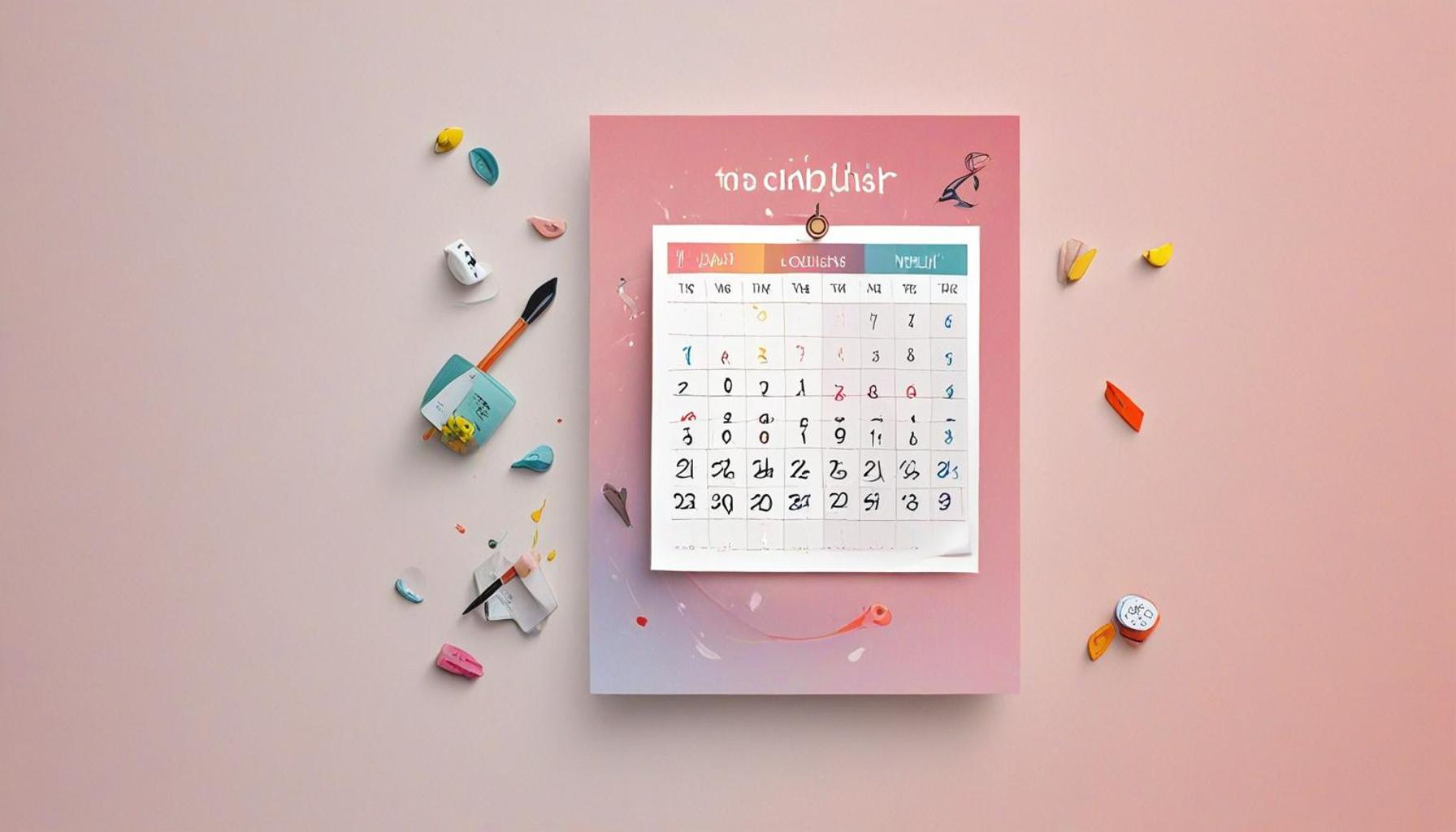How to Create a Minimalist Calendar: The Importance of Simple Visualization for Time Management

Embrace Simplicity in Planning
In a world that increases in complexity with every passing day, the ability to streamline our lives is more crucial than ever. Clutter, both physical and mental, can suffocate even the most systematic individuals. This phenomenon is particularly evident when it comes to managing our schedules. Enter the minimalist calendar: a transformative tool that distills your commitments into clear, manageable segments. By embracing the principles of minimalism, you can revamp your time management strategies for improved productivity and well-being.
Why Minimalism?
Minimalism prioritizes the essential by eliminating excess. Whether you are navigating a busy workweek, organizing personal appointments, or balancing social engagements, a minimalist approach can offer clarity. Some compelling reasons to shift towards a minimalist calendar include:
- Reduces Stress: A clean layout devoid of unnecessary distractions fosters a sense of calm. For instance, research has shown that physical clutter can lead to cognitive overload, resulting in heightened stress. By simplifying your visual representation of time, you can alleviate such pressure.
- Enhances Focus: A minimalist calendar allows you to zero in on priorities. Rather than becoming overwhelmed by a sea of color-coded tasks, straightforward visuals enable you to pinpoint crucial deadlines and appointments. This feature is particularly beneficial for professionals managing multiple projects, as it ensures that the most urgent tasks come into clear view.
- Saves Time: With a streamlined perspective, the decision-making process becomes more efficient. A well-structured calendar leads to quicker assessments of your day or week, allowing for spontaneous adjustments or the reallocation of tasks with minimal fuss.
Benefits of Visualization
The power of visualization in time management cannot be overstated. By utilizing simple techniques, you can reap a multitude of benefits:
- Clarity: A minimalist calendar is designed for easy readability. In a mere glance, you should be able to assess your commitments without squinting at tiny print or deciphering chaotic designs.
- Organization: Categorizing tasks becomes intuitive with a clean layout. Rather than being bogged down by intricate details, you can swiftly identify groupings of responsibilities—be they work-related, personal, or social.
- Adaptability: Life is anything but static. A minimalist calendar is inherently flexible, allowing you to adjust plans or implement new strategies easily as situations evolve. Whether you’re filling in gaps due to cancellations or re-scheduling a meeting, your calendar should evolve with you.
Implementing a minimalist calendar is not just about tracking your events; it is about optimizing how you interact with your time and energy. By stripping away the superfluous, you create ample room for what truly matters—effectively propelling your productivity to unprecedented heights. Dive deeper into the principles of crafting your minimalist calendar, and you may find that the pursuit of simplicity is precisely the guide you need in today’s whirlwind lifestyle.
DISCOVER MORE: Click here to dive deeper
Crafting Your Minimalist Calendar: First Steps
Creating a minimalist calendar is a straightforward process, but it requires careful consideration to ensure it aligns with your lifestyle and objectives. Start with understanding your needs: Are you managing a busy work schedule, family commitments, or personal projects? Tailoring your calendar to reflect your priorities is essential for maximum effectiveness. Here are practical steps to guide you in constructing a minimalist calendar that works:
1. Choose Your Format
The first decision in designing your minimalist calendar involves selecting a format that suits your preferences. You might lean towards digital calendars, which can be easily updated and accessed from multiple devices, or opt for a physical planner, which can provide a tactile experience that many find satisfying. Regardless of your choice, ensure that the design emphasizes simplicity. A clutter-free layout helps in visualizing your time at a glance.
2. Limit Color Coding
While color coding is a popular method for organizing tasks, using too many colors can become overwhelming. For a minimalist calendar, it’s advisable to stick to a limited palette. Choose one or two colors to represent different categories, such as work and personal appointments. This approach not only maintains a clean aesthetic but also makes it easier to focus on what is important. Adopting a consistent color scheme can further enhance clarity and enhance your ability to quickly locate relevant information.
3. Prioritize Essential Entries
As you begin filling in your calendar, prioritize essential entries. Start with fixed commitments, such as meetings, deadlines, and major events. From there, incorporate flexible tasks and appointments. A minimalist calendar should reflect your true priorities; hence, avoid adding every single task or to-do item. Instead, focus on the top three to five tasks you want to accomplish each day. This practice promotes accountability and ensures you don’t spread yourself too thin.
4. Maintain White Space
A common mistake in calendar design is overcrowding with information. A minimalist calendar thrives on white space, which helps to create a sense of balance and tranquility. Leave ample space between entries to minimize visual clutter, allowing your eyes to rest and enhancing the overall readability. This space provides mental breathing room and promotes a clearer mindset as you navigate your commitments.
5. Regularly Review and Adjust
Minimalism is not a one-time endeavor; it’s an ongoing practice. Set aside time each week to review your calendar. Assess the current layout, remove tasks that have lost relevance, and adjust entries based on evolving priorities. This commitment to regular review ensures your calendar continues to serve your needs while reflecting the changing nature of your life. By continually refining your minimalist calendar, you foster a more adaptive approach to time management.
In summary, creating a minimalist calendar is about designing a personalized tool that emphasizes simplicity and clarity. By making intentional choices in format, color coding, prioritization, and layout, you empower yourself to manage your time effectively. This foundational step sets the stage for a more organized and productive lifestyle, where each moment is leveraged toward your essential goals.
Creating a minimalist calendar is not just about aesthetics; it’s a methodology that enhances productivity and clarity in our busy lives. The core of a minimalist calendar lies in its ability to simplify complex schedules into clear and actionable items, which can significantly benefit time management. First and foremost, a minimalist calendar minimizes distractions. Unlike traditional planners brimming with colors and decorations, minimalist designs focus on essential information. This helps users to avoid the overwhelming feeling that often comes with cluttered calendars. By keeping only the necessary events and dates visible, you can prioritize your tasks more effectively.Another advantage of a minimalist calendar is that it encourages reflection and planning. With a visual layout stripped of excess elements, users are prompted to assess their commitments critically. This leads to more meaningful scheduling, as it allows for a better understanding of how time is allocated throughout the day or week.Moreover, a minimalist calendar promotes consistency. When you get used to a streamlined way of organizing your time, it creates a habit that can spill over into other areas of your life. The simplicity encourages regular usage, which is vital for improving productivity and maintaining organization.In addition, there’s a psychological aspect to this approach. Knowing that you have a clear and concise format for managing time can reduce anxiety levels associated with schedules. It empowers users to take control of their time management, facilitating better decision-making in both personal and professional life.Finally, integrating digital tools that enhance minimalist principles can greatly improve efficiency. Many apps and platforms now support customized minimalist calendars, allowing users to tailor layouts according to their unique needs. This customization fosters engagement and increases the likelihood of individuals adhering to their schedules.In summary, adopting a minimalist calendar design can significantly impact how one views and manages their time, making it an ideal solution for anyone looking to improve their productivity and time management habits. Engaging with this simple yet powerful visualization technique can help individuals reclaim control over their busy lives.
DISCOVER MORE: Click here to learn how mindful consumption can elevate your organization
Enhancing Your Minimalist Calendar: Refining the Process
Now that you have crafted the foundation of your minimalist calendar, the next steps revolve around enhancing its functionality and usability. A well-designed calendar not only organizes your time but also serves as a visual reminder of your goals, thereby helping you maintain focus and productivity. Here are additional strategies to refine your minimalist calendar and make it more effective for your time management needs:
6. Incorporate Time Blocking
One of the most effective techniques in minimalist time management is time blocking. This practice involves dividing your day into distinct time slots allocated for specific activities or tasks. By assigning dedicated blocks of time to critical activities, you create clear distinctions between work, relaxation, and personal projects. For instance, designate mornings for deep work, afternoons for meetings, and evenings for personal engagements. This method not only enhances concentration but also reduces decision fatigue by limiting the number of choices you need to make throughout the day.
7. Utilize Symbols and Icons
To maintain a minimalist aesthetic while adding functionality, consider using simple symbols or icons to denote various types of tasks or events. A star can signify priority tasks, while a clock icon could indicate time-specific appointments. Utilizing these intuitive visuals can enhance the readability of your calendar without overwhelming it. This method allows for quick scanning while keeping your design clean and engaging, which can prompt immediate recognition of what needs to be done.
8. Set Boundaries with Your Calendar
To further strengthen your time management skills, it is essential to define the boundaries of your calendar. Avoid the tendency to overflow your calendar with unnecessary commitments. This might mean consciously choosing to say no to events or tasks that do not align with your core goals. Setting clear boundaries not only protects your time but promotes a healthier work-life balance. Additionally, this practice reinforces the minimalist philosophy that less is often more, fostering an environment where priorities are front and center.
9. Leverage Technology Mindfully
For those who opt for digital minimalist calendars, it’s vital to leverage technology mindfully. Numerous apps exist that focus on simplicity and effectiveness, such as Google Calendar, Todoist, or Notion. However, in a digital setup, it’s crucial to avoid feature overload; stick to applications that resonate best with your minimalist ethos. Limit the number of calendars you integrate, focusing solely on essential categories. This streamlined approach prevents distraction and enhances focus, ultimately contributing to a more effective time management system.
10. Inspire Yourself with Quotes or Affirmations
Incorporating motivational quotes or personal affirmations into your minimalist calendar can provide an inspiring touch. These simple reminders can boost your morale and encourage action, ensuring that your calendar functions as more than just a scheduling tool. Whether it’s a quote about productivity or a personal mantra, reflect these messages visually in your planner to keep your mindset aligned with your goals. They serve as gentle nudges toward accountability and reinforce the overarching theme of intentional living.
By integrating these additional components into your minimalist calendar, you create a dynamic tool that is not only functional but also personally gratifying. These refinements allow for greater flexibility and adaptability, ultimately paving the way for more efficient time management skills. As you navigate through your commitments, your calendar becomes a powerful ally in your quest for balance and productivity.
DISCOVER MORE: Click here for minimalist tips
Conclusion: Embracing Minimalism for Effective Time Management
In a world overflowing with distractions and commitments, adopting a minimalist calendar can be a game changer for enhancing your time management skills. By focusing on simplicity, you create a visual tool that not only organizes your schedule but also prioritizes your goals. The strategies discussed throughout this article—such as incorporating time blocking, utilizing intuitive symbols, and setting firm boundaries—empower you to navigate your daily responsibilities with clarity and purpose.
The minimalist approach is more than just a design choice; it reflects a philosophy of intentional living that encourages mindfulness in how we spend our time. By reducing overwhelm and decluttering our schedules, we foster an environment conducive to productivity and well-being. Moreover, engaging with technology mindfully can further streamline your time management, helping you stay focused on what truly matters.
As you journey into crafting and refining your minimalist calendar, remember that the ultimate goal is to create a system that resonates with your personal values and aspirations. This system, stripped of excess, becomes not just a planner, but a source of inspiration and accountability. By embracing the power of simple visualization, you position yourself for greater success, balance, and fulfillment. Now is the time to take action—transform your calendar into your ally in the quest for an organized, meaningful life.


